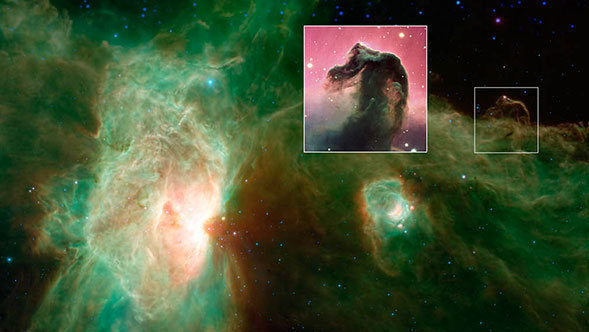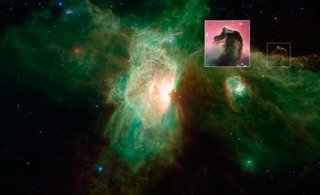
News Release • December 19th, 2014 • feature14-23 •
Sometimes a horse of a different color hardly seems to be a horse at all, as, for example, in this newly released image from NASA's Spitzer Space Telescope. The famous Horsehead nebula makes a ghostly appearance on the far right side of the image, but is almost unrecognizable in this infrared view. In visible-light images, the nebula has a distinctively dark and dusty horse-shaped silhouette, but when viewed in infrared light, dust becomes transparent and the nebula appears as a wispy arc.
The Horsehead is only one small feature in the Orion Molecular Cloud Complex, dominated in the center of this view by the brilliant Flame nebula (NGC 2024). The smaller, glowing cavity falling between the Flame nebula and the Horsehead is called NGC 2023. These regions are about 1,200 light-years away.
The two carved-out cavities of the Flame nebula and NGC 2023 were created by the destructive glare of recently formed massive stars within their confines. They can be seen tracing a spine of glowing dust that runs through the image.
The Flame nebula sits adjacent to the star Alnitak, the easternmost star in Orion’s belt, seen here as the bright blue dot near the top of the nebula.
In this infrared image from Spitzer, blue represents light emitted at a wavelength of 3.6-microns, and cyan (blue-green) represents 4.5-microns, both of which come mainly from hot stars. Green represents 8-micron light and red represents 24-micron light. Relatively cooler objects, such as the dust of the nebulae, appear green and red. Some regions along the top and bottom of the image extending beyond Spitzer's observations were filled in using data from NASA's Wide-field Infrared Survey Explorer, or WISE, which covered similar wavelengths across the whole sky.
NASA's Jet Propulsion Laboratory, Pasadena, California, manages the Spitzer Space Telescope mission for NASA's Science Mission Directorate, Washington. Science operations are conducted at the Spitzer Science Center at the California Institute of Technology in Pasadena. Spacecraft operations are based at Lockheed Martin Space Systems Company, Littleton, Colorado. Data are archived at the Infrared Science Archive housed at the Infrared Processing and Analysis Center at Caltech. Caltech manages JPL for NASA.





